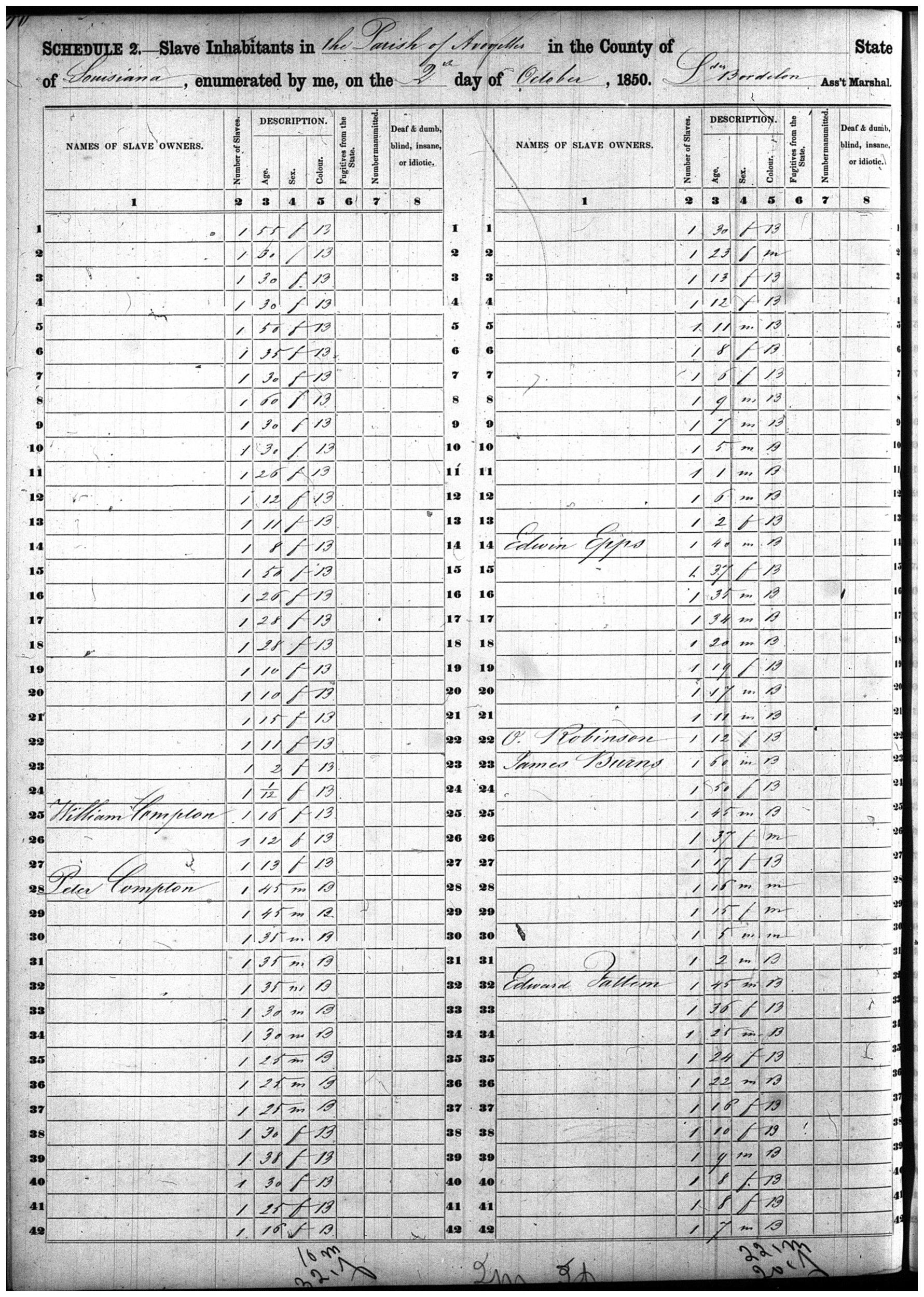Twelve Years a Slave
Making Connections
All documents and text associated with this activity are printed below, followed by a worksheet for student responses.Introduction
Solomon Northup was a free man of color who was kidnapped and sold into slavery. He told his story in his autobiography "Twelve Years a Slave." Here you will read passages from his autobiography and analyze documents that relate to his life. Provide your answers in the empty boxes following the questions.Name:
Class:
Class:
Worksheet
Twelve Years a Slave
Making Connections
Examine the documents and text included in this activity. Fill in any blanks in the sequence with your thoughts and write your conclusion response in the space provided.As far back as I have been able to ascertain, my ancestors on the paternal side were slaves in Rhode Island. They belonged to a family by the name of Northup, one of whom, removing to the State of New York, settled at Hoosic, in Rensselaer county. He brought with him Mintus Northup, my father. On the death of this gentleman, which must have occurred some fifty years ago, my father became free, having been emancipated by a direction in his will....Sometime after my father's liberation, he removed to the town of Minerva, Essex county, N.Y., where I was born, in the month of July, 1808.
(p.18-19)
(p.18-19)
On Christmas Day, 1829, I was married to Anne Hampton, a colored girl then living in the vicinity of our residence. ...
With the return of spring, Anne and myself conceived the project of taking a farm in the neighborhood. I had been accustomed from earliest youth to agricultural labors, and it was an occupation congenial to my tastes. I accordingly entered into arrangements for a part of the old Alden farm, on which my father formerly resided. With one cow, one swine, a yoke of fine oxen I had lately purchased of Lewis Brown, in Hartford, and other personal property and effects, we proceeded to our new home in Kingsbury. That year I planted twenty-five acres of corn, sowed large fields of oats, and commenced farming upon as large a scale as my utmost means would permit. Anne was diligent about the house affairs, while I toiled laboriously in the field.
On this place we continued to reside until 1834.
(p. 20-21, 23-24)
With the return of spring, Anne and myself conceived the project of taking a farm in the neighborhood. I had been accustomed from earliest youth to agricultural labors, and it was an occupation congenial to my tastes. I accordingly entered into arrangements for a part of the old Alden farm, on which my father formerly resided. With one cow, one swine, a yoke of fine oxen I had lately purchased of Lewis Brown, in Hartford, and other personal property and effects, we proceeded to our new home in Kingsbury. That year I planted twenty-five acres of corn, sowed large fields of oats, and commenced farming upon as large a scale as my utmost means would permit. Anne was diligent about the house affairs, while I toiled laboriously in the field.
On this place we continued to reside until 1834.
(p. 20-21, 23-24)
Question:
Look at the 1830 Census, first along the left side to find Solomon's name and then along the top to look at the categories. Make sure to look at both pages of the census record.
Notice in the record how Solomon Northup's entry is documented compared to the rest of the individual's listed on the census record. How are they different?
Look at the 1830 Census, first along the left side to find Solomon's name and then along the top to look at the categories. Make sure to look at both pages of the census record.
Notice in the record how Solomon Northup's entry is documented compared to the rest of the individual's listed on the census record. How are they different?
Population Schedule for Kingsbury, Washington County, New York
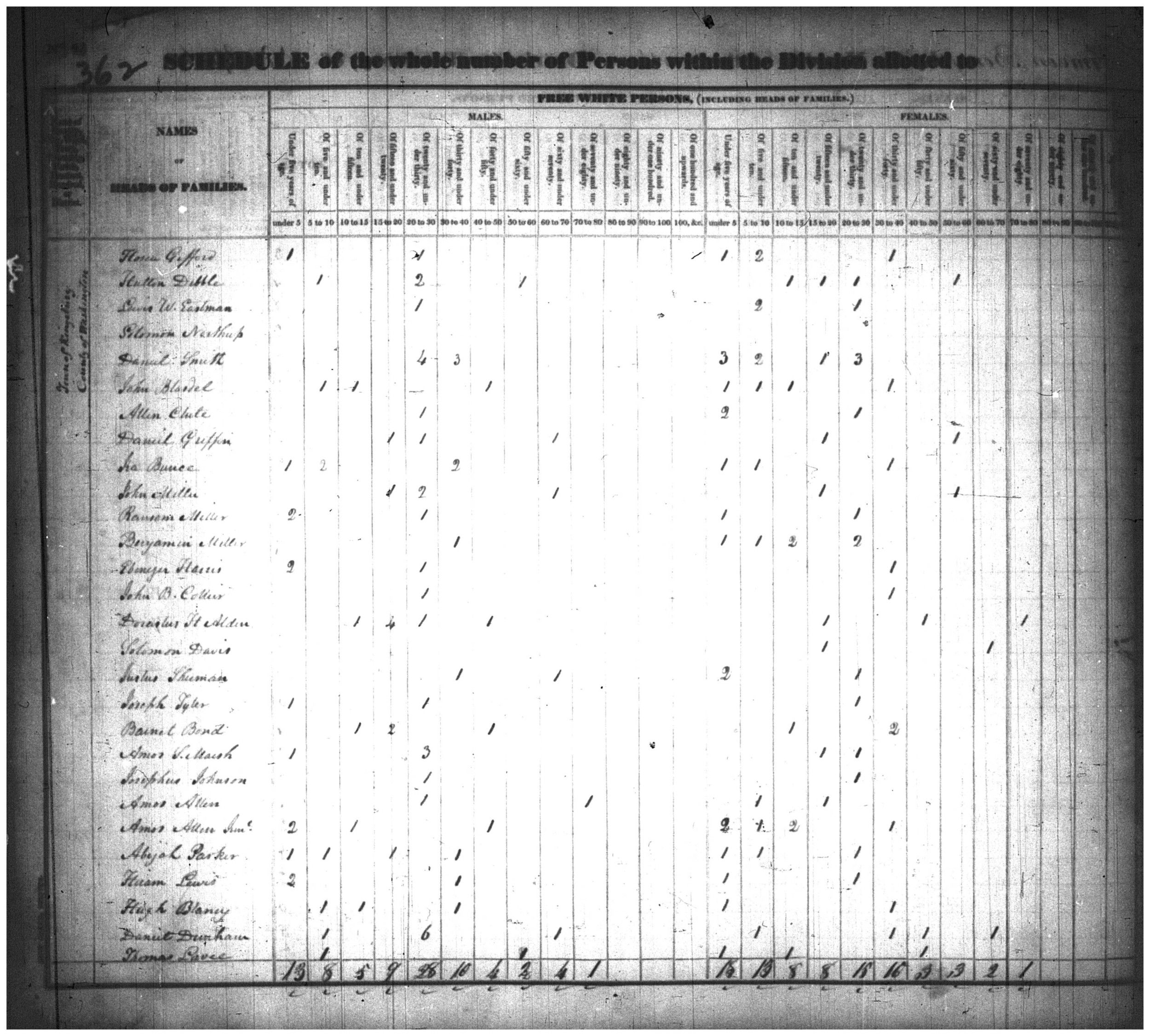
Enter your response
I continued to reside at Saratoga until the spring of 1841. ...
At this time we were the parents of three children--Elizabeth, Margaret, and Alonzo. Elizabeth, the eldest, was in her tenth year; Margaret was two years younger, the little Alonzo had just passed his fifth birth-day. They filled our house with gladness. Their young voices were music in our ears. Many an airy castle did their mother and myself build for the little innocents. When not at labor I was always walking with them, clad in their best attire, through the streets and groves of Saratoga.
(p. 26-27)
Questions:
Look at the 1840 Census.
Where is Solomon Northup living?
Who is living with him?
Look at the 1840 Census.
Where is Solomon Northup living?
Who is living with him?
Population Schedule for Saratoga Springs, Saratoga County, New York
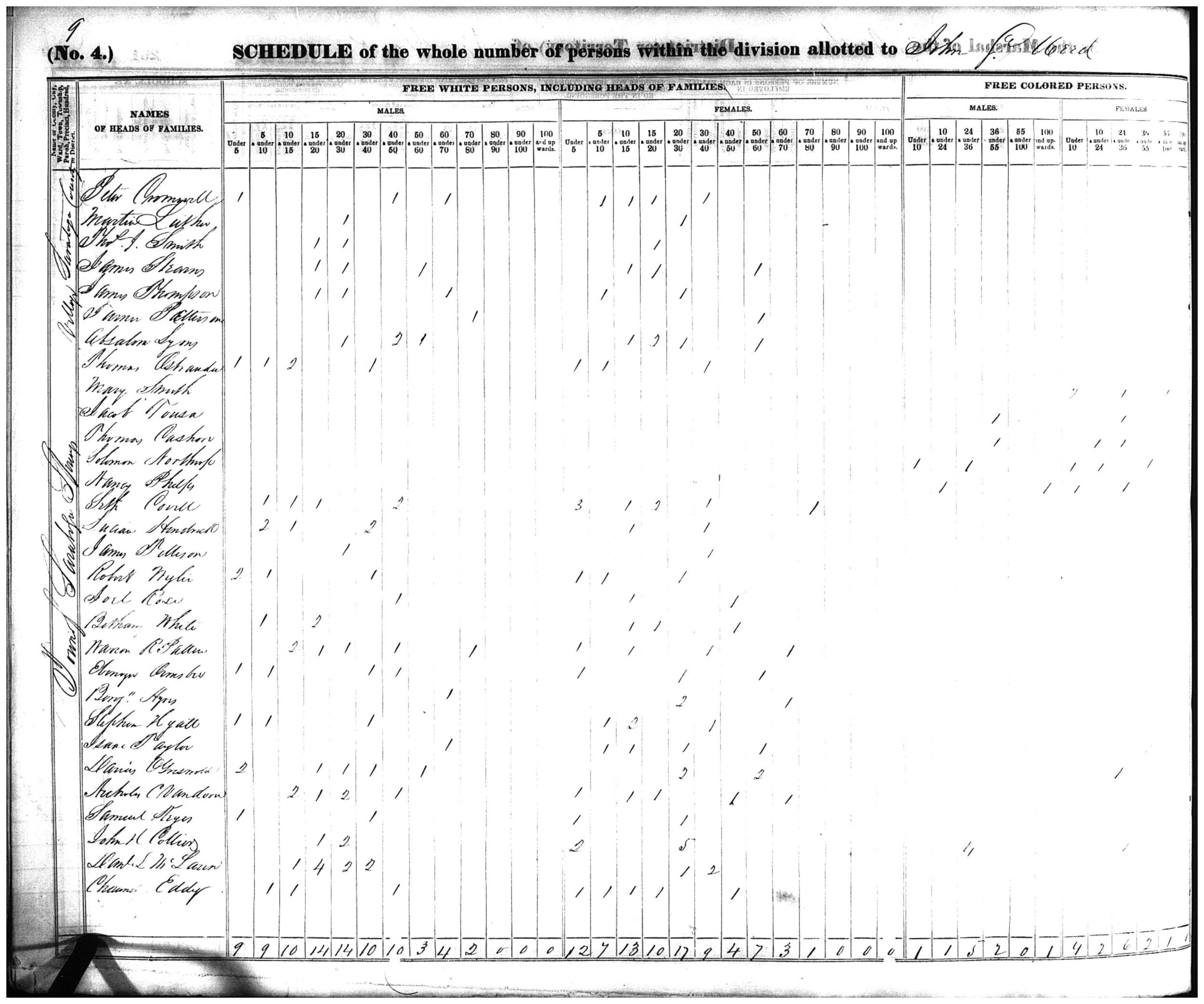
Enter your response
The pain in my head had subsided in a measure, but I was very faint and weak. I was sitting upon a low bench, made of rough boards, and without coat or hat. I was hand cuffed. Around my ankles also were a pair of heavy fetters. One end of a chain was fastened to a large ring in the floor, the other to the fetters on my ankles. I tried in vain to stand upon my feet. Waking from such a painful trance, it was some time before I could collect my thoughts. Where was I? What was the meaning of these chains?...What had I done to deserve imprisonment in such a dungeon? I could not comprehend. There was a blank of some indefinite period, preceding my awakening in that lonely place, the events of which the utmost stretch of memory was unable to recall. I listened intently for some sign or sound of life, but nothing broke the oppressive silence, save the clinking of my chains, whenever I chanced to move. I spoke aloud, but the sound of my voice startled me. I felt of my pockets, so far as the fetters would allow—far enough, indeed, to ascertain that I had not only been robbed of liberty, but that my money and free papers were also gone! Then did the idea begin to break upon my mind, at first dim and confused, that I had been kidnapped. But that I thought was incredible. (p. 38)
In the afternoon we were drawn up, two abreast, Robert and myself in advance, and in this order, driven by Burch and Goodin from the yard, through the streets of Richmond to the brig Orleans. She was a vessel of respectable size, full rigged, and freighted principally with tobacco. We were all on board by five o'clock. Burch brought us each a tin cup and a spoon. There were forty of us in the brig....
(p. 63-64)
(p. 63-64)
Very soon traders and consignees came on board. One, a tall, thin-faced man, with light complexion and a little bent, made his appearance, with a paper in his hand. Burch's gang, consisting of myself, Eliza and her children, Harry, Lethe, and some others, who had joined us at Richmond, were consigned to him. This gentleman was Mr. Theophilus Freeman. Reading from his paper, he called, "Platt." No one answered. The name was called again and again, but still there was no reply. Then Lethe was called, then Eliza, then Harry, until the list was finished, each one stepping forward as his or her name was called.
"Captain, where's Platt?" demanded Theophilus Freeman.
The captain was unable to inform him, no one being, on board answering to that name.
"Who shipped him?" he again inquired of the captain, pointing to me.
"Burch," replied the captain.
"Your name is Platt—you answer my description. Why don't you come forward?" he demanded of me, in an angry tone.
I informed him that was not my name; that I had never been called by it, but that I had no objection to it as I knew of. (p. 75-76)
"Captain, where's Platt?" demanded Theophilus Freeman.
The captain was unable to inform him, no one being, on board answering to that name.
"Who shipped him?" he again inquired of the captain, pointing to me.
"Burch," replied the captain.
"Your name is Platt—you answer my description. Why don't you come forward?" he demanded of me, in an angry tone.
I informed him that was not my name; that I had never been called by it, but that I had no objection to it as I knew of. (p. 75-76)
Questions:
Slave manifests were required by law to document slaves being shipped from one port to another.
What is the name of the ship?
What port did the ship leave from?
What port did the ship sail to?
What name is given to Solomon Northup?
What number is he on the manifest?
What is his age? His height? His complexion?
Slave manifests were required by law to document slaves being shipped from one port to another.
What is the name of the ship?
What port did the ship leave from?
What port did the ship sail to?
What name is given to Solomon Northup?
What number is he on the manifest?
What is his age? His height? His complexion?
Slave Manifest for the Brig Orleans
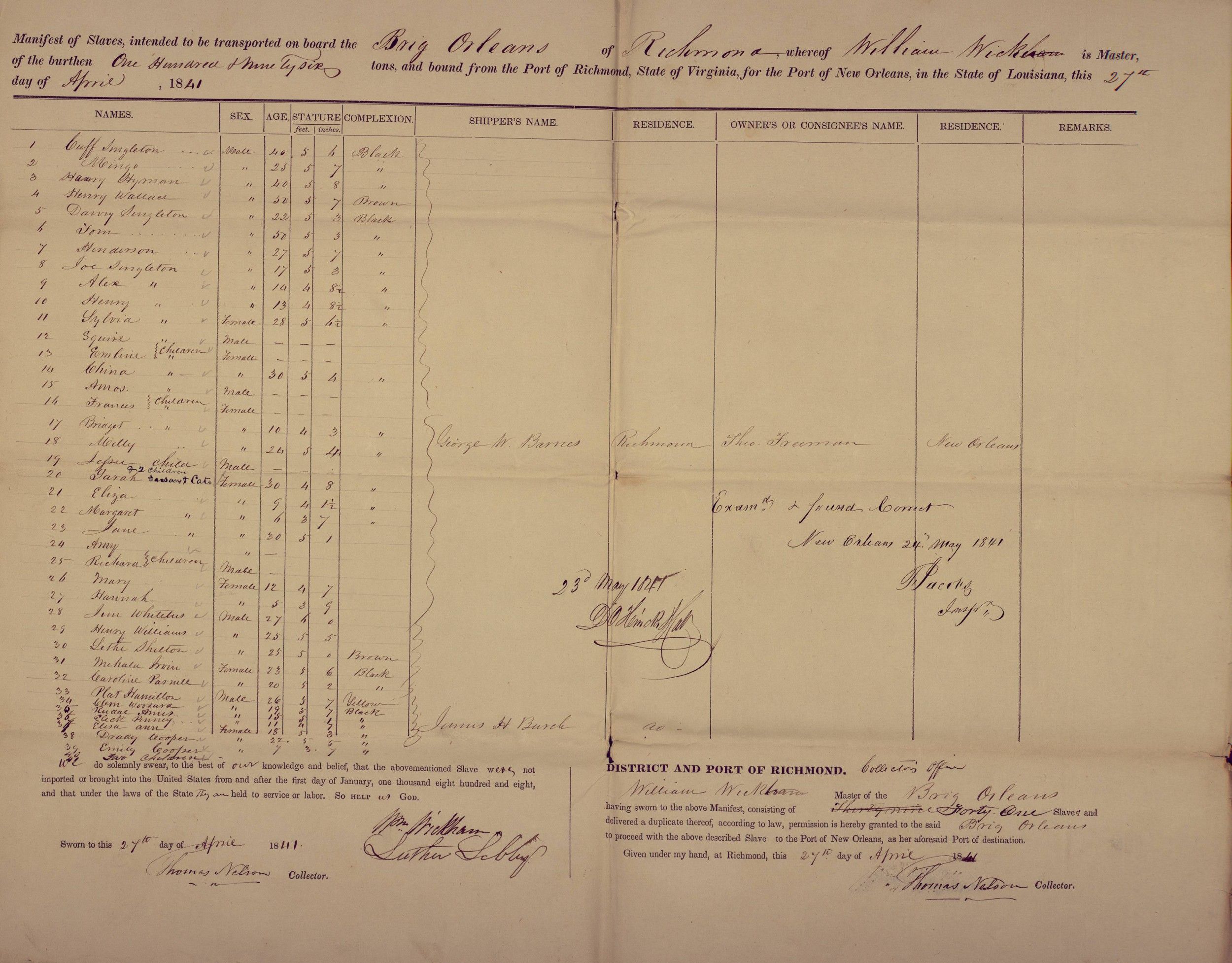
Enter your response
Edwin Epps, of whom much will be said during the remainder of this history, is a large, portly, heavybodied man with light hair, high cheek bones, and a Roman nose of extraordinary dimensions. He has blue eyes, a fair complexion, and is, as I would say, full six feet high. ...
His manners are repulsive and coarse, and his language gives speedy and unequivocal evidence that he has never enjoyed the advantages of an education. ...
He had been a driver and overseer in his younger years, but at this time was in possession of a plantation on Bayou Huff Power, ... It belonged to Joseph B. Roberts, his wife's uncle, and was leased by Epps. His principal business was raising cotton, ...
(p. 162-163)
His manners are repulsive and coarse, and his language gives speedy and unequivocal evidence that he has never enjoyed the advantages of an education. ...
He had been a driver and overseer in his younger years, but at this time was in possession of a plantation on Bayou Huff Power, ... It belonged to Joseph B. Roberts, his wife's uncle, and was leased by Epps. His principal business was raising cotton, ...
(p. 162-163)
Questions:
The Census of 1850 included a Slave Schedule where all slaves were counted. Look at the 1850 Slave Schedule .
Which slave owned by Edwin Epps do you think could be Solomon Northup (Platt Hamilton)?
What information leads you to believe this?
The Census of 1850 included a Slave Schedule where all slaves were counted. Look at the 1850 Slave Schedule .
Which slave owned by Edwin Epps do you think could be Solomon Northup (Platt Hamilton)?
What information leads you to believe this?
Slave Inhabitants in the Parish of Avoyelles, State of Louisiana

Enter your response
After twelve years, Solomon Northup regains his freedom with assistance from Henry B. Northup the descendant of his father, Mintus Northup's original owner.
1
Activity Element
Population Schedule for Kingsbury, Washington County, New York
Page 1

2
Activity Element
Population Schedule for Saratoga Springs, Saratoga County, New York
Page 1

3
Activity Element
Slave Manifest for the Brig Orleans
Page 1

4
Activity Element
Slave Inhabitants in the Parish of Avoyelles, State of Louisiana
Page 1

Conclusion
Twelve Years a Slave
Making Connections
Answer: - How do these documents corroborate Northup's autobiography Twelve Years a Slave? - How does Solomon's story relate to the Fugitive Slave Act? - Write three paragraphs answering these questions. Use specific evidence from the documents to support your argument.You can read the entire "Twelve Years a Slave" on the University of North Carolina's "Documenting the American South."
Your Response
Document
Population Schedule for Kingsbury, Washington County, New York
1830
This census page from the town of Kingsbury, in Washington County, New York, includes Solomon Northup, a free man of color and his family (the fourth name listed). The 1830 census documented White persons, free persons of color, and enslaved people in different categories. Look at the second image to see where Northup and his family are tallied under "Free Colored Persons."
Northup was later kidnapped and sold into slavery. After he was freed years later, he told his life story in his autobiography Twelve Years a Slave: Narrative of Solomon Northup, a Citizen of New-York, Kidnapped in Washington City in 1841 and Rescued in 1853, from a Cotton Plantation Near the Red River in Louisiana.
Northup was later kidnapped and sold into slavery. After he was freed years later, he told his life story in his autobiography Twelve Years a Slave: Narrative of Solomon Northup, a Citizen of New-York, Kidnapped in Washington City in 1841 and Rescued in 1853, from a Cotton Plantation Near the Red River in Louisiana.
This primary source comes from the Records of the Bureau of the Census.
National Archives Identifier: 7490028
Full Citation: Population Schedule for Kingsbury, Washington County, New York; 1830; Population Schedules for the 1830 Census, 1830 - 1830; Records of the Bureau of the Census, ; National Archives Building, Washington, DC. [Online Version, https://docsteach.org/documents/document/kingsbury-census, April 25, 2024]Population Schedule for Kingsbury, Washington County, New York
Page 1
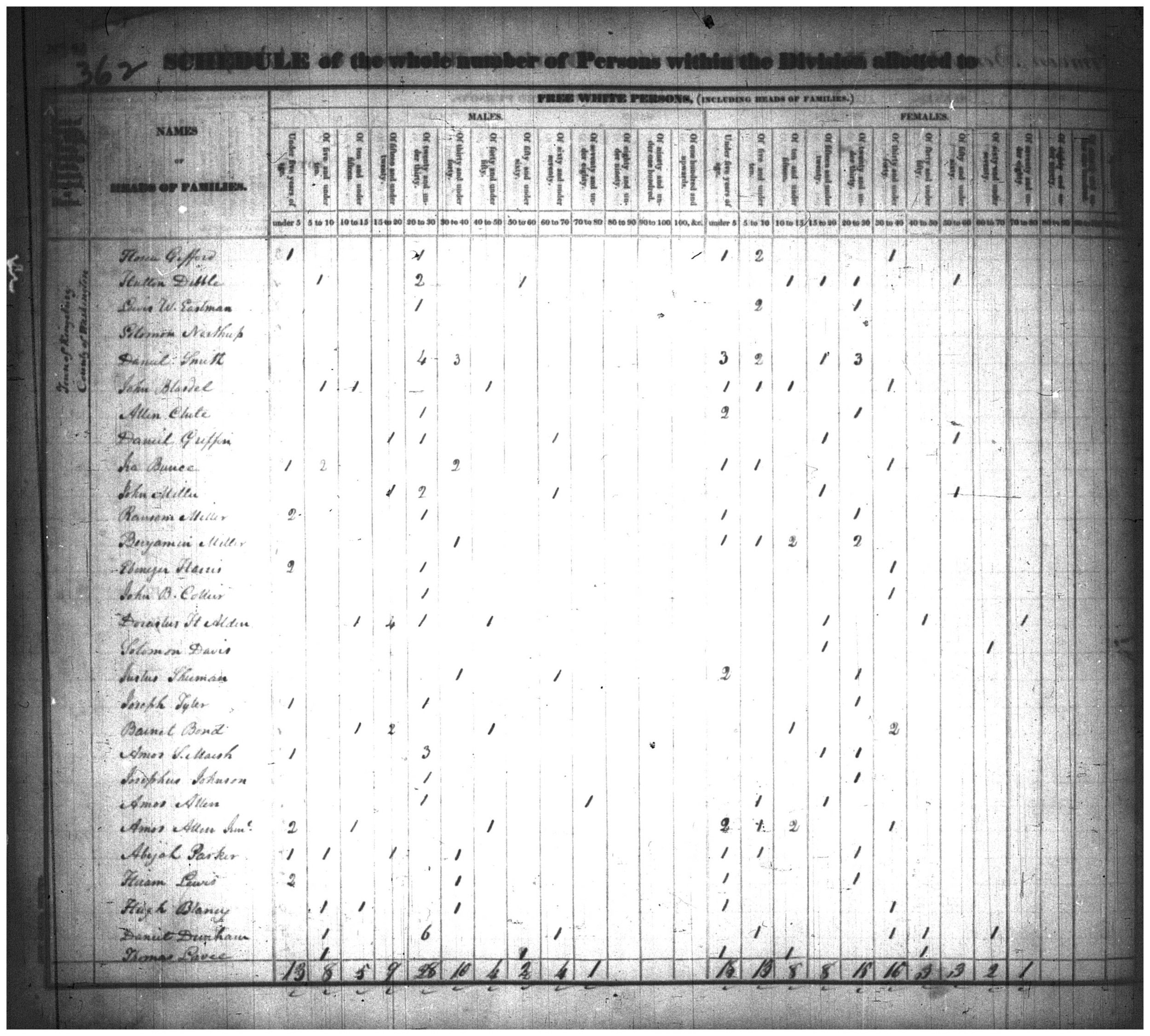
Population Schedule for Kingsbury, Washington County, New York
Page 2

Document
Population Schedule for Saratoga Springs, Saratoga County, New York
1840
This census page from the town of Saratoga Springs, New York, includes Solomon Northup, a free man of color and his family (the 12th name listed). The 1840 census documented White persons, free persons of color, and enslaved people in different categories. Northup and his family are tallied under "Free Colored Persons."
Northup was later kidnapped and sold into slavery. He told his life story in his autobiography Twelve Years a Slave: Narrative of Solomon Northup, a Citizen of New-York, Kidnapped in Washington City in 1841 and Rescued in 1853, from a Cotton Plantation Near the Red River in Louisiana.
Northup was later kidnapped and sold into slavery. He told his life story in his autobiography Twelve Years a Slave: Narrative of Solomon Northup, a Citizen of New-York, Kidnapped in Washington City in 1841 and Rescued in 1853, from a Cotton Plantation Near the Red River in Louisiana.
This primary source comes from the Records of the Bureau of the Census.
National Archives Identifier: 7490029
Full Citation: Population Schedule for Saratoga Springs, Saratoga County, New York; 1840; Population Schedules for the 1840 Census, 1840 - 1840; Records of the Bureau of the Census, ; National Archives Building, Washington, DC. [Online Version, https://docsteach.org/documents/document/census-saratoga-springs, April 25, 2024]Population Schedule for Saratoga Springs, Saratoga County, New York
Page 1

Population Schedule for Saratoga Springs, Saratoga County, New York
Page 2
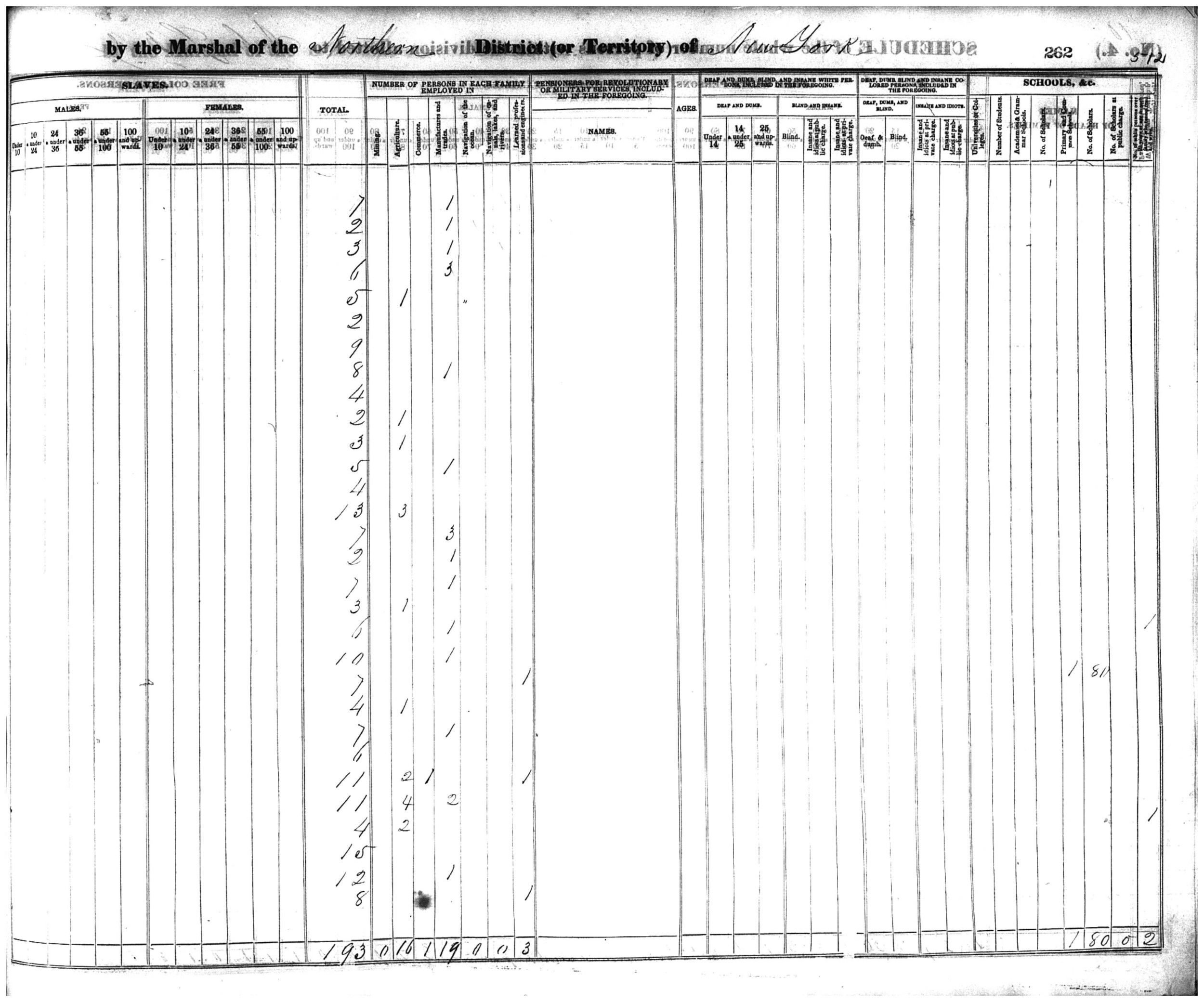
Document
Slave Manifest for the Brig Orleans
4/27/1841–5/24/1841
This manifest shows 41 enslaved people who were shipped to New Orleans, Louisiana, from Richmond, Virginia. Among them was Solomon Northup, who was listed as Plat Hamilton on line 33. A free person of color in New York, Northup had been kidnapped and sold into slavery; he was given the name Plat Hamilton aboard the ship. Years later, after he regained his freedom, he told his life story in his autobiography Twelve Years a Slave: Narrative of Solomon Northup, a Citizen of New-York, Kidnapped in Washington City in 1841 and Rescued in 1853, from a Cotton Plantation Near the Red River in Louisiana.
It had became illegal to import slaves from other countries to the United States in 1808. The domestic slave trade, however, remained legal. With the rise of cotton as a southern commodity, thousands of enslaved people were shipped from the upper south to the lower south regularly from 1808–1860. Slave manifests were required by law for each ship transporting slaves and needed to include every slave's name, sex, height, and complexion or class. In addition, slave manifests required the names of the slave owners or shippers and their residence, plus the names of the individuals the slaves were consigned to if necessary. Two copies of these manifests were required, one would be filed with the customs agent at the port of departure, and the other manifest would be filed at the port of arrival. The customs agents were required to sign these manifests.
It had became illegal to import slaves from other countries to the United States in 1808. The domestic slave trade, however, remained legal. With the rise of cotton as a southern commodity, thousands of enslaved people were shipped from the upper south to the lower south regularly from 1808–1860. Slave manifests were required by law for each ship transporting slaves and needed to include every slave's name, sex, height, and complexion or class. In addition, slave manifests required the names of the slave owners or shippers and their residence, plus the names of the individuals the slaves were consigned to if necessary. Two copies of these manifests were required, one would be filed with the customs agent at the port of departure, and the other manifest would be filed at the port of arrival. The customs agents were required to sign these manifests.
This primary source comes from the Records of the U.S. Customs Service.
National Archives Identifier: 7456569
Full Citation: Slave Manifest for the Brig Orleans; 4/27/1841–5/24/1841; May 1841; Slave Manifests, 1817 - 1861; Records of the U.S. Customs Service, ; National Archives at Fort Worth, Fort Worth, TX. [Online Version, https://docsteach.org/documents/document/slave-manifest-brig-orleans, April 25, 2024]Slave Manifest for the Brig Orleans
Page 1

Document
Slave Inhabitants in the Parish of Avoyelles, State of Louisiana
1850
In the 1850 census, enslaved people were enumerated (counted) separately on what was called a "slave schedule." The name of the owner was recorded; but unfortunately, most schedules do not provide personal names for enslaved persons. In most cases, individuals were simply numbered and can be distinguished only by age, sex, and skin color.
This single page from the Parish of Avoyelles, in Louisiana, on October 2, 1850, includes Edwin Epps (Eppes) and a list of his slaves. One of these descriptions (35 year old male) is for Solomon Northup (also known as Platt Hamilton), whose life story is told in his autobiography Twelve Years a Slave: Narrative of Solomon Northup, a Citizen of New-York, Kidnapped in Washington City in 1841 and Rescued in 1853, from a Cotton Plantation Near the Red River in Louisiana. Northup had been kidnapped and shipped from Richmond, VA, to New Orleans, LA, where he was sold into slavery and eventually purchased by Eppes.
This single page from the Parish of Avoyelles, in Louisiana, on October 2, 1850, includes Edwin Epps (Eppes) and a list of his slaves. One of these descriptions (35 year old male) is for Solomon Northup (also known as Platt Hamilton), whose life story is told in his autobiography Twelve Years a Slave: Narrative of Solomon Northup, a Citizen of New-York, Kidnapped in Washington City in 1841 and Rescued in 1853, from a Cotton Plantation Near the Red River in Louisiana. Northup had been kidnapped and shipped from Richmond, VA, to New Orleans, LA, where he was sold into slavery and eventually purchased by Eppes.
This primary source comes from the Records of the Bureau of the Census.
National Archives Identifier: 7490030
Full Citation: Slave Inhabitants in the Parish of Avoyelles, State of Louisiana; 1850; Population Schedules for the 1850 Census, 1850 - 1850; Records of the Bureau of the Census, ; National Archives Building, Washington, DC. [Online Version, https://docsteach.org/documents/document/slave-inhabitants-avoyelles, April 25, 2024]Slave Inhabitants in the Parish of Avoyelles, State of Louisiana
Page 1
